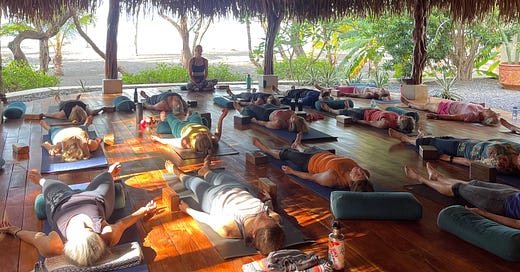6 Mind and Body Exercises We Are Doing at the Panama Brain Health Retreat
Plus, you can try one of our favorites—Yoga Nidra—at home with this free download.
Hello from Cambutal, Panama! It’s the second day of the Brain Health Retreat. The journey was long but I ate well on the way, thanks to my brain food travel satchel. Thanks to everyone who shared their favorite travel foods in the last post. I look forward to mixing it up with your suggestions on my next trip.
Today, I thought it would be fun to give you a behind-the-scenes look at the exercise program at the Retreat. Over the years, my retreat partner Stacy Fisher of Fisher Fitness has created a series of classes that combine brain and body fitness. We focus on all the evidence-based ways movement can protect the brain: building strength, cardiovascular conditioning, and deep restorative work.
Stacy’s approach is unique in how she engages the brain during each class. Have you ever counted backwards from 100 by 7’s as you do lunges and squats? Or, retraced your steps for the course of a day (or more) while doing intervals on a stationary bike? Read on for more ideas how you may be able to make your workouts even more beneficial for your brain.
Don’t miss the Yoga Nidra download Stacy is sharing for free below!
What exercise does for your brain
Learning how to create a sustainable personalized fitness program is just as important as finding your own just-right brain healthy way of eating. But what kind of exercise is best, and how much time should you spend? First, let’s take a look at a few of the ways exercise may help protect the brain from age-related cognitive decline:
Enhances blood flow to the brain
Fosters neurogenesis—how new brain cells are made
Boosts brain-derived neurotrophic factor (BDNF)
Grows the hippocampus, the memory center of the brain
New data shows that exercise may also enhance pre-synaptic proteins in the brain. This means more synapses fire, enhancing brain cells connectivity and signaling, and preventing brain cell death that often comes with age. The result is a brain that is resilient to Alzheimer’s pathology.
How much exercise and what kind is best for brain health?
According to the World Health Organization, the recommendation for cardiovascular fitness is 150 to 300 minutes per week. Cardiovascular exercise is any movement that is moderately intense. While working out, you should have some difficulty singing a song or talking to your exercise partner. There’s good news if you love to exercise: additional brain health benefit may result from doing cardio for more than 300 minutes per week.
Exercise doesn’t mean just cardio, though. For older adults, there’s evidence that any type of movement can reduce dementia risk. (Dr. Andrew E. Budson goes into how light physical activity counts here.) Plus, strength training and restorative work is just as important for both overall fitness and brain health.




